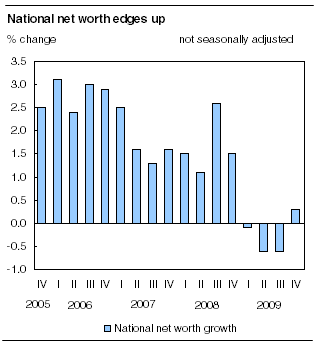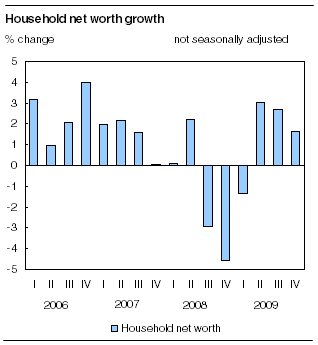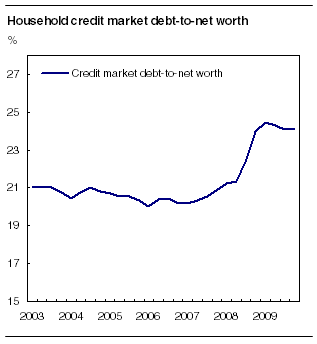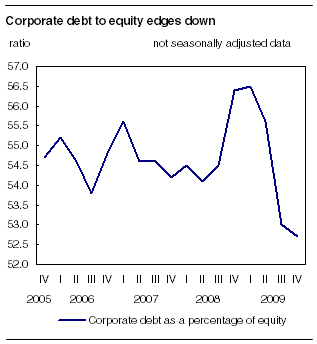Common menu bar links
National balance sheet accounts
Archived Content
Information identified as archived is provided for reference, research or recordkeeping purposes. It is not subject to the Government of Canada Web Standards and has not been altered or updated since it was archived. Please "contact us" to request a format other than those available.
Related subjects
National net worth edged up 0.3% (or $20 billion) to $6 trillion in the fourth quarter, reflecting a 0.7% increase in national wealth, particularly residential real estate assets. The advance in national net worth was moderated by a $19 billion increase in net foreign debt, as a decline in national saving led to the need for greater financing from abroad.

The increase in net foreign debt in the fourth quarter was split equally between borrowing from abroad to finance the current account deficit and the revaluation effect from the appreciation of the Canadian dollar, which lowered the value of international assets more than the value of international liabilities. During the fourth quarter of 2009, foreign holdings of Canadian bonds were up strongly while gains in foreign equity markets were moderated by the currency revaluation effect.
On a per capita basis, national net worth remained largely unchanged from the third quarter at $175,900.
Household net worth increases
Household net worth was up $93 billion (+1.6%) to $5.9 trillion in the fourth quarter. Increases in the value of financial assets, especially equities and life insurance and pensions, as well as an increase in residential real estate, largely accounted for the increase in net worth. This was partially offset by rising financial liabilities, particularly mortgages.
Owner's equity as a percentage of real estate assets remained relatively unchanged (67.8%) in the fourth quarter, but nonetheless continued its downward trend that started in the third quarter of 2008.
Note to readers
The national balance sheet accounts are comprised of the balance sheets of all of the sectors of the economy: the persons and unincorporated business (households), corporate, government and non-resident sectors. They cover all national non-financial assets and financial claims and associated liabilities outstanding in all sectors.
National net worth is national wealth less net foreign liabilities (i.e., what is owed to non-residents less what non-residents owe to Canadians). Alternatively, it is the sum of the net worth of the persons and unincorporated business, corporate and government sectors.
Household credit market debt is comprised of consumer credit, mortgage, and loan debt of households, non-profit institutions serving households and unincorporated businesses.
Corporate equity is treated as a liability on the balance sheet of the corporate sector, as it represents a claim by shareholders on the corporate sector. As a result, as equity prices increase, corporate net worth will tend to decline, reflecting the increase in their equity liabilities.
Quarterly series, both book and market value, are available from the first quarter of 1990. Marketable securities are at market value, unless otherwise stated. For more information on the market value estimates, consult the Balance sheet estimates at market value page of our website.
As of 2009 third quarter release of the National Balance Sheet Accounts (NBSA), a number of sectors and categories that were previously published have been combined in order to provide more relevant sector and category information.
Market value estimates in the NBSA on annual and quarterly bases have been expanded. Annual market value data are published for all sectors from 1970, while book value estimates remain available from 1961. Quarterly data are available for all sectors from the first quarter of 1990 for market and book value estimates. The release of these estimates will facilitate comparisons with other countries.
Household net worth per capita grew to $172,600 during the fourth quarter.

The Standard and Poor's / Toronto Stock Exchange Index increased almost 3%, marking the third consecutive quarterly advance and pushing the index to a year-over-year increase of over 30%. This contributed to gains in equity holdings of households in the fourth quarter, albeit at a slower rate than the previous quarter.
Households increased their mortgage liabilities, reflecting continuing strength in existing home sales and renovation activity as well as an increase in new housing construction.
The credit market debt-to-income ratio for households increased from 143.0% in the third quarter to 144.4% in the fourth. In other words, households had $144 in debt in the fourth quarter for every $100 of disposable income.
Lower interest rates kept the debt-service ratio low for the most part of 2009. This ratio rose slightly in the fourth quarter to 7.42%.
While the household debt-to-income ratio increased steadily in 2009, the ratio of household debt to net worth remained relatively stable during the year.

Government net debt continues to advance
The net worth of the government sector declined $20 billion in the fourth quarter, as net debt continued to advance.
Both provincial and federal governments raised funds largely by issuing bonds. The federal government retired short-term debt, moderating the increase in overall liabilities.
Nevertheless, overall government sector net debt (at book value) as a percentage of gross domestic product increased to 43.7% from 42.3% in the previous quarter and from 36.3% in the fourth quarter of 2008. The year-over-year increase in net debt to gross domestic product was the first year-over-year advance since 1995 and the largest since 1992.
Corporate debt to equity edges down
Equity financing of non-financial corporations slowed in the fourth quarter from the third quarter while bond issuance strengthened. However, overall equity issues and retained earnings outpaced borrowing and the ratio of credit market debt to equity (at book value) declined further.

Institutional investors, such as trusteed pension plans and mutual funds, increased their overall investment in marketable securities, notably provincial bonds and short-term paper. Consistent with the increase in the asset value of life insurance and pensions of household sector, the liabilities of institutional investors in the form of life insurance and pensions advanced in the fourth quarter. Financial institutions recorded a smaller rise in their holdings of equities in the fourth quarter compared with the third quarter, in line with reduced share issues.
Available on CANSIM: tables 378-0012 to 378-0014 and 378-0049 to 378-0116.
Definitions, data sources and methods: survey number 1806.
The fourth quarter 2009 National Balance Sheet Accounts: Data Tables, Vol. 2, no. 4 (13-022-X, free), is now available from the Key resource module of our website under Publications.
For more information, or to enquire about the concepts, methods or data quality of this release, contact the information officer (613-951-3640; iead-info-dcrd@statcan.gc.ca), Income and Expenditure Accounts Division.
Table 1
| Third quarter 2008 | Fourth quarter 2008 | First quarter 2009 | Second quarter 2009 | Third quarter 2009 | Fourth quarter 2009 | Third quarter to fourth quarter 2009 | |
|---|---|---|---|---|---|---|---|
| Market value, not seasonally adjusted | |||||||
| $ billions | change in $ billions | ||||||
| National net worth1 | 5,942 | 6,030 | 6,022 | 5,985 | 5,949 | 5,969 | 20 |
| 2.6 | 1.5 | -0.1 | -0.6 | -0.6 | 0.3 | ... | |
| National wealth1 | 5,958 | 5,976 | 5,992 | 5,993 | 5,999 | 6,039 | 40 |
| 1.9 | 0.3 | 0.3 | 0.0 | 0.1 | 0.7 | ... | |
| Net foreign debt | -15 | 54 | 30 | -8 | -51 | -70 | -19 |
| National net worth, by sector | |||||||
| Household sector | 5,789 | 5,526 | 5,452 | 5,615 | 5,766 | 5,859 | 93 |
| Corporate sector | 153 | 528 | 604 | 402 | 237 | 183 | -54 |
| Government sector | 0 | -24 | -33 | -32 | -54 | -74 | -20 |
| $ | change in dollars | ||||||
| National net worth per capita | 177,600 | 179,900 | 179,100 | 177,400 | 175,600 | 175,900 | 300 |
Table 2
| Third quarter 2008 | Fourth quarter 2008 | First quarter 2009 | Second quarter 2009 | Third quarter 2009 | Fourth quarter 2009 | |
|---|---|---|---|---|---|---|
| Market value, not seasonally adjusted | ||||||
| Household sector | ||||||
| Net worth | ||||||
| Household net worth per capita ($) | 173,000 | 164,800 | 162,200 | 166,400 | 170,200 | 172,600 |
| Net worth as a percentage of personal disposable income (%) | 615.39 | 581.07 | 570.26 | 583.73 | 598.61 | 605.14 |
| Total assets to net worth (%) | 122.82 | 124.37 | 124.85 | 124.66 | 124.42 | 124.44 |
| Financial assets to net worth (%) | 67.61 | 66.90 | 67.04 | 68.24 | 68.81 | 68.97 |
| Financial assets to non-financial assets (%) | 122.47 | 116.41 | 115.95 | 120.96 | 123.73 | 124.33 |
| Owner's equity as a percentage of real estate (%) | 69.85 | 69.03 | 68.66 | 68.16 | 67.96 | 67.78 |
| Real estate as a percentage of personal disposable income (%) | 293.74 | 288.49 | 285.19 | 284.74 | 288.03 | 290.49 |
| Debt | ||||||
| Household debt ($ billions) | 1,321 | 1,346 | 1,355 | 1,384 | 1,408 | 1,432 |
| Household debt per capita ($) | 39,500 | 40,200 | 40,300 | 41,000 | 41,600 | 42,200 |
| Credit market debt ($ billions) | 1,302 | 1,326 | 1,335 | 1,364 | 1,389 | 1,415 |
| Debt to personal disposable income (%) | 138.55 | 140.12 | 142.57 | 143.31 | 144.95 | 146.20 |
| Credit market debt to personal disposable income (%) | 136.51 | 138.04 | 140.35 | 141.18 | 143.02 | 144.43 |
| Consumer credit and mortgage liabilities to personal disposable income (%) | 124.94 | 126.31 | 128.69 | 129.73 | 131.79 | 133.23 |
| Debt to total assets (%) | 18.58 | 19.59 | 19.90 | 19.78 | 19.62 | 19.64 |
| Debt to net worth (%) | 22.82 | 24.37 | 24.85 | 24.66 | 24.42 | 24.44 |
| Credit market debt to net worth (%) | 22.49 | 24.00 | 24.48 | 24.30 | 24.09 | 24.14 |
| Consumer credit and mortgage liabilities to net worth (%) | 20.59 | 21.96 | 22.42 | 22.30 | 22.18 | 22.27 |
| Debt to gross domestic product (%) | 82.69 | 84.14 | 85.41 | 88.75 | 92.05 | 93.73 |
Table 3
| Third quarter 2008 | Fourth quarter 2008 | First quarter 2009 | Second quarter 2009 | Third quarter 2009 | Fourth quarter 2009 | |
|---|---|---|---|---|---|---|
| Market value, not seasonally adjusted | ||||||
| Corporate sector | ||||||
| Net new issuance of debt, non-financial corporations ($ billions) | 14 | 11 | 4 | 6 | -7 | 0 |
| Net new issuance of debt, financial corporations ($ billions) | 10 | 52 | 26 | 12 | 4 | 16 |
| Net new issuance of share equity, non-financial corporations ($ billions) | 1 | 1 | 5 | 8 | 19 | 8 |
| Private non-financial corporations total debt to equity (%) | 170.13 | 180.25 | 179.76 | 173.30 | 168.92 | 166.30 |
| Private non-financial corporations credit market debt to equity (book value) (%) | 54.48 | 56.44 | 56.54 | 55.58 | 52.99 | 52.67 |
Table 4
| Third quarter 2008 | Fourth quarter 2008 | First quarter 2009 | Second quarter 2009 | Third quarter 2009 | Fourth quarter 2009 | |
|---|---|---|---|---|---|---|
| Market value, not seasonally adjusted | ||||||
| Government sector | ||||||
| Net new issuance of debt, federal government ($ billions) | 0 | 56 | 48 | 10 | 26 | 4 |
| Net new issuance of debt, other levels of government ($ billions) | 12 | 15 | -2 | 21 | 2 | 22 |
| Total government gross debt (book value) - ($ billions) | 1,395 | 1,473 | 1,538 | 1,561 | 1,603 | 1,631 |
| Federal government gross debt (book value) - ($ billions) | 614 | 673 | 732 | 736 | 771 | 777 |
| Other levels of government gross debt (book value) - ($ billions) | 771 | 794 | 800 | 822 | 829 | 851 |
| Total government net debt (book value) - ($ billions) | -566 | -580 | -605 | -625 | -648 | -668 |
| Federal government net debt (book value) - ($ billions) | -476 | -467 | -480 | -493 | -506 | -518 |
| Other levels of government net debt (book value) - ($ billions) | -243 | -259 | -271 | -280 | -290 | -299 |
| Total government net debt (book value) to gross domestic product (%) | 35.45 | 36.28 | 38.12 | 40.06 | 42.35 | 43.72 |
| Federal government net debt (book value) to gross domestic product (%) | 29.79 | 29.19 | 30.24 | 31.63 | 33.11 | 33.89 |
| Other levels of government net debt (book value) to gross domestic product (%) | 15.24 | 16.21 | 17.07 | 17.94 | 18.97 | 19.58 |

